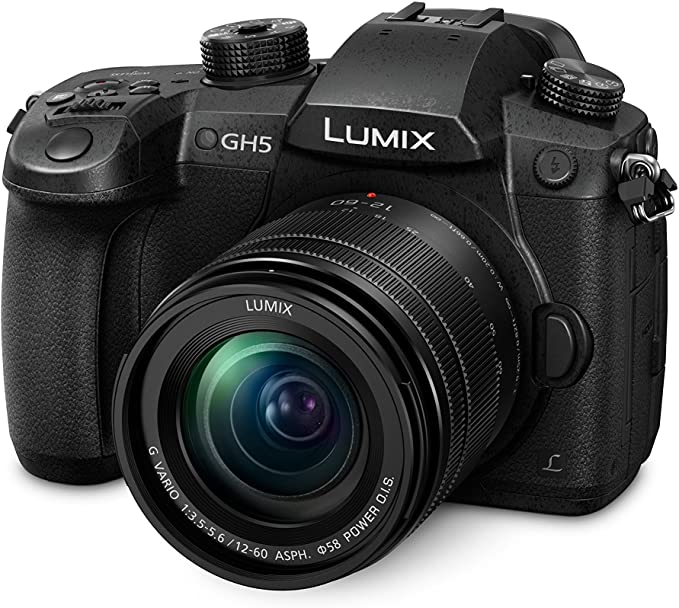Panasonic Lumix DC-GH5MEB-K Compact system.
Panasonic LUMIX DC-GH5MEB-K Compact System
Mirrorless Camera with 12-60mm Lens – Black
About this item

The marriage of an advanced Digital Live MOS sensor with the beautiful new Venus Engine 10 reproduces extraordinary color detail and natural texture expression. The Three-Dimensional Colour Control with rich colors from dark to bright shades and high-precision Multi Process NR makes your images stand out.
It isn’t easy to handhold a camera at the best of times, but thanks to the 5-axis Dual image, Stabiliser 2 Intelligent compensation comes to your aid. The LUMIX GH5 eliminates shakes in both body and lens from wide-angle to tele-end.
Faster frame rates mean excellent motion compensation, plus you can slow down footage inside your video editing timeline without losing detail. You also achieve perfect panning control and a suppression of the rolling shutter effect, as seen in lesser frame rates.
It can also achieve High-resolution images and perfect focal length as the LUMIX GH5 features Pixel with no sensor cropping recording. There’s also no recording duration limit so that you can go beyond 30 minutes in all record settings.
The LUMIX GH5 brings a game-changing internal 4:2:2 10-bit 4K video recording. The power of having film creation capabilities inside the camera sets a new precedent in guerrilla-style filmmaking.
Dfd (depth from defocus) allows the camera to calculate focal lens movement by comparing the depth of field values of two images at incredibly high speeds. A motion detector accurately tracks fast-moving subjects and enables smooth 4K photo/video & 6K photo recording.
Shoot with unlimited burst, then choose and extract the exact frames you want to keep. The new 6K photo mode at 30fps allows you to capture the perfect moments at a stunning approx.18-Megapixel high-resolution.
Product Description
The LUMIX GH5 packs a real punch with its high performance Digital Live MOS sensor sporting 20.3 megapixels to achieve the highest picture quality in the history of LUMIX G compact system cameras. By removing the low-pass filter from the sensor, you can confidently capture the sharpest & artifact-free image with a high dynamic range. The LUMIX GH5 is a camera of beauty created by you and crafted by Panasonic engineering.
Top reviews
I have three GH2 which I have used for some years for multi-camera shooting and editing on an Avid Media Composer, but by all accounts, getting files from a GH5 into the Avid is problematic, especially if you want to take advantage of 10-bit files. Could I perhaps shoot in 4k but edit in HD and get benefits over the GH2? It t seems I can, and the resulting HD, upscaled in my OPPO BDP-103 and viewed on my 65″ Samsung 4k television, is stunning – the best I have ever seen, even on the best Blu rays, and a massive improvement over the HD from my GH2’s. So I have a neat solution – shoot in 4k 8-bit and edit to HD with the possibility of editing in 4k later. Shooting in 10-bit is more problematic, though; If I select MOV file format, which is necessary to allow 25p 10-bit video, then I can neither play them on the TV (which is not HDR – I will try on an LG OLED later.) nor edit them in my existing system. It seems that at present, the only way to get 4k 10-bit from the GH4 into Avid (or I think Premier) is to transcode it first into an edit-friendly format (like DNxHR for Avid), so I will await developments in editing before going to 10-bit.
I didn’t expect to be able to use the 4k files directly in my Avid without transcoding, but I was surprised to find that I can drag and drop 4k 8-bit files into an Avid bin, and they convert immediately even though the Avid is V5.5 which is a few years out of date. The process does take about 8min per minute of video, about twice what HD takes, and it probably works because it uses QuickTime codecs to convert and find the codec even though I have not updated the Avid for 4k working. The resulting HD edited video is the best I have ever seen – as good as the best blu ray video. Aliasing is superficial – the usual trade-off between detailed resolution and aliasing inherent in using an optical ‘phase plate’ anti-aliasing filter is gone since this camera dispenses with optical filtering and digitally filters instead from the high-resolution sensor.